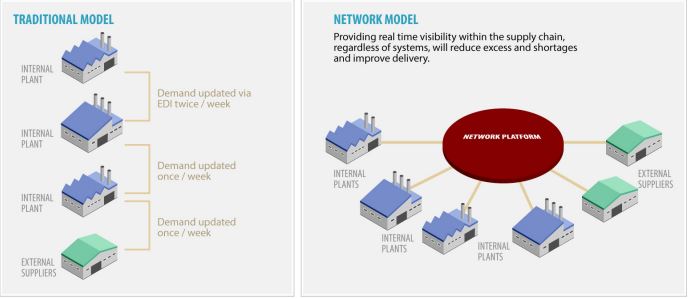This post has already been read 6065 times!
Companies re-assessing the nature of their supply chains are shifting priorities and realizing new value
What is a Supply Chain?
The supply chain is the processes and the flow of goods from the source to the end-consumer. The unfortunate paradigm of a chain, a sequence of links, has contributed to the confusion about what a supply chain really is, and has hindered progress in supply chain management.
There are two implications of the chain paradigm:
Enterprise Silos – companies have been internally focused, with functions within the company operating in departmental silos, and with pairing with external trading partners as secondary consideration.
Sequential Batch Processing – information and goods flow sequentially from link to link via periodic batch processes.
This has led to every company standing as an island with point-to-point “pipes” between trading partners where information is periodically pushed through.
The consequences are disconnected processes both within the company and across the supply chain. Another consequence of chain paradigm is that planning and execution are traditionally viewed sequentially and supported through different systems, with huge volumes of data being copied from silo to silo. This takes hours and means that execution systems are actually running on stale data. The world has moved on since the original snapshot, yet that historical data still drives the supply chain.
These unnecessary delays and the compounding of bad data with bad decisions, results in supply-demand mismatch, shortages, overstocks and poor customer service. (For more on how information delay impacts the supply chain, see The Science of Supply Chain Optimization, detailing research by Dr. David Nowicki and Dr. Wesley Randall at the University of North Texas.)
The True Nature of Supply Chains

Experts and companies are realizing that the supply chain is not really a chain at all, it’s a network of business partners. This has very different implications for how companies should be connected and transact.
Business systems should be multi-party at core, and accurately represent the dynamic relationships among trading partners. -Dr. Adeel Najmi Share on XConnecting and trading with other companies is the essence of business, and in today’s dynamic, global environment, it’s more important than ever to be able to quickly and easily connect with trading partners.
Communication and collaboration must be real-time in order to fully optimize the supply chain. Delays and stale data cost time and money. (For more on how information delays negatively impact the supply chain, see The Science of Theoretical Minimums by Dr. David Nowicki and Wesley Randall of the University of North Texas.)
What is a Supply Network?
There are different types of networks, but not all overcome the problems of supply chain. Let’s look at the four criteria for a true network.
- Accurate network representation with a focus on the big picture
Business systems should be multi-party at core, and accurately represent the dynamic relationships between trading partners so they can optimize based on the full range of information in the network. They should understand and consider the cost-service trade-off when it comes to serving the customer. This eliminates waste instead of moving it around the network, and it optimizes the entire supply network so everybody wins.
- Multi-Party Data Management
Enterprise-centric solutions contribute to duplicated, contradictory and stale data. A network solution acknowledges that transactions are executed among multiple parties, and that a single transaction can have multiple views. For example a purchase order and a sales order are really the same transaction and should be represented by the same data object. Network solutions accommodate this with simple data models that reduce complexity, errors and the multitude of messages and message types that enterprise solutions spawn.
- Hub-to-Hub Architecture
Many networks today are built in with a hub-and-spoke architecture. This merely mirrors the enterprise-centric nature of traditional enterprise systems. It creates a feudal-like system, with the spoke companies serving the hub, and gaining the lion’s share of value. In a multi-party network every company is a hub. Every company has equal access to other companies on the network and can use the full functionality of solutions on the network.
- Robust Permissibility Framework and Security
At the heart of a true network solution lies a robust and sophisticated permissions framework. This ensures that each company on the network only has access to its own data, and that data-sharing with business partners is precisely and strictly controlled.
Aligning for Multi-Party Networks and Better Results
The network model has huge benefits for businesses, including simpler solutions, faster supply chains, lower costs and higher value. In a follow up post I’ll give three design guidelines that enable companies to re-engineer processes for a network and help companies achieve breakthrough results.
How a Multi-Party Network Creates a Jump in Gains
- Why Your Supply Chain Needs Blockchain - March 7, 2018
- What Supply Chains Really are and Why it Matters - November 9, 2017
- What is Machine Learning? - September 29, 2017
